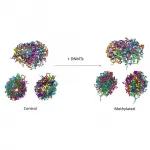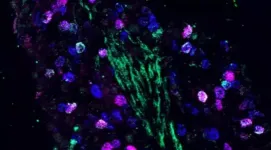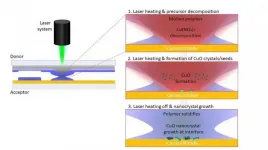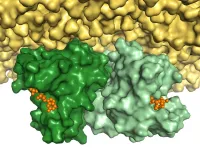(Press-News.org) Materials have a variety of properties that can be used to solve computational problems, according to studies in substrate-based computing. BZ computers, slime mould computers, plant computers, and collision-based liquid marbles computers are just a few examples of prototypes produced for future and emergent computing devices. Modelling the computational processes that exist in such systems, however, is a difficult task in general, and determining which part of the embodied system is doing the computation is still somewhat ill-defined.
Claiming that fungi are the most intelligent living organisms in the world sounds like an exaggeration. However, a recent study by Mohammad Mahdi Dehshibi, a UOC researcher who is contributing to a growing body of knowledge on the use of fungal materials, concurs with this idea. Its implications are numerous and practical in both the medium and the long term. They include the possibility of using fungal tissues as actual computing devices. How could we use a fungus as if it were a computer?
Converting the fungal electrical signals into messages
Fungal mycelium like Pleurotus djamor, also known as the pink oyster mushroom, can resolve an incredible range of computational geometry problems, explained Mohammad Mahdi Dehshibi in a previously published article on fungal materials. "By changing the environmental conditions, we can reprogramme a geometry and a theoretical structure of the graphics of mycelium networks and then use the electrical activity of the fungi to create computing circuits", confirmed the researcher.
In a recent study, Electrical activity of fungi: Spikes detection and complexity analysis, published by Mohammad Mahdi Dehshibi of the Scene Understanding and Artificial Intelligence Lab (SUNAI) group at the UOC Faculty of Computer Science, Multimedia and Telecommunications, in collaboration with Andrew Adamatzky of the Unconventional Computing Laboratory at the UWE Bristol, the researchers demonstrate that the pink oyster mushroom generates a series of spikes in electrical potential that are propagated by a growing mycelium.
The electrical activity property of the fungus corresponds to the extremely complex internal communication it uses, and this can be analysed and utilized to operate and develop computing measures. In the research project, the authors propose a variety of measures to be able to "translate" these electrical signals into messages according to the classification of the spikes in potential that can be detected.
The electrical signals in the fungal tissue are so faint and complex that it is impossible to analyse them using the standard techniques of neuroscience, the discipline that traditionally measures them. The researchers' proposal consists of a method for detecting spike arrival time through an exhaustive algorithm that enables fairly efficient characterization of the electrical activity.
The key to the complex language of fungi
Fungi are among the largest, most widely distributed and oldest groups of living organisms in the world. The many advantages for which they are considered an interesting material include their tremendous availability at no cost, their resilience, their capacity for self-maintenance and their rapid growth. To all of this, as demonstrated in the study, we must add the communicative complexity shown by the electrical signals of the fungus.
To obtain a better idea, the researchers have proven that the complexity of this "language" is greater than that of many human languages in terms of communication. That reality opens up the possibility of using the signals as an efficient and practical means of information transmission and computing, giving fungi a very interesting potential as computers.
"At the moment, there are two major challenges to be confronted [in being able to use fungi as computers]", explained Dehshibi. "The first is to implement a computing purpose that makes sense. The second is to characterize the properties of the fungal substrates to discover their true computational potential". These two steps are essential for building functional computing units.
Designing environmental sensors
Will we really see, then, a laptop computer with a microprocessor made with fungi? For the author, the objective of fungal computers is not to replace silicon chips, as the actions in this type of computer are too slow for that. But the properties of fungi could be used as an "environmental sensor on a large scale". Fungal networks could monitor large quantities of data flows as part of their day-to-day activity. If we were able to connect to their networks and interpret the signals, they use to process information, we could learn more about what is happening in an ecosystem and act accordingly.
INFORMATION:
This research project is in line with Sustainable Development Goal (SDG) 9, to build resilient infrastructure, promote sustainable industrialization and foster innovation.
Related paper
Mohammad Mahdi Dehshibi, Andrew Adamatzky. "Electrical activity of fungi: Spikes detection and complexity analysis". Biosystems (2021). https://doi.org/10.1016/j.biosystems.2021.104373
UOC R&I
The UOC's research and innovation (R&I) is helping overcome pressing challenges faced by global societies in the 21st century, by studying interactions between technology and human & social sciences with a specific focus on the network society, e-learning and e-health. Over 500 researchers and 51 research groups work among the University's seven faculties and two research centres: the Internet Interdisciplinary Institute (IN3) and the eHealth Center (eHC).
The United Nations' 2030 Agenda for Sustainable Development and open knowledge serve as strategic pillars for the UOC's teaching, research and innovation. More information: research.uoc.edu. #UOC25years
Eating at least two serves of fruit daily has been linked with 36 percent lower odds of developing type 2 diabetes, a new Edith Cowan University (ECU) study has found.
The study, published today in the Journal of Clinical Endocrinology and Metabolism, revealed that people who ate at least two serves of fruit per day had higher measures of insulin sensitivity than those who ate less than half a serve.
Type 2 diabetes is a growing public health concern with an estimated 451 million people worldwide living with the condition. A further 374 million people are at increased risk of developing type 2 diabetes.
The study's lead author, Dr Nicola ...
Researchers at Linköping University in Sweden have developed an app to help women achieve a healthy weight gain and lifestyle during a pregnancy. The results from an evaluation of the app have now been published in two scientific articles. Using the app contributed to a better diet. Pregnant women with overweight or obesity who received the app also gained less weight during pregnancy.
"Pregnancy is a phase in life when many people try to do what is best for themselves and their baby. We think it's important to be able to offer a tool that has ...
Good acoustics in the workspace improve work efficiency and productivity, which is one of the reasons why acoustic materials matter. The acoustic insulation market is already expected to hit 15 billion USD by 2022 as construction firms and industry pay more attention to sound environments. Researchers at Aalto University, in collaboration with Finnish acoustics company Lumir, have now studied how these common elements around us could become more eco-friendly, with the help of cellulose fibres.
'Models for acoustic absorption are based on tests done with synthetic fibres, and ...
An international research team determined that ancestors of modern domestic horses and the Przewalski horse moved from the territory of Eurasia (Russian Urals, Siberia, Chukotka, and eastern China) to North America (Yukon, Alaska, continental USA) from one continent on another at least twice. It happened during the Late Pleistocene (2.5 million years ago - 11.7 thousand years ago). The analysis results are published in the journal. The findings and description of horse genomes are published in the journal Molecular Ecology.
"We found out that the Beringian Land Bridge, or the area known as Beringia, influenced genetic ...
All the cells of an organism share the same DNA sequence, but their functions, shapes or even lifespans vary greatly. This happens because each cell "reads" different chapters of the genome, thus producing alternative sets of proteins and embarking on different paths. Epigenetic regulation--DNA methylation is one of the most common mechanisms--is responsible for the activation or inactivation of a given gene in a specific cell, defining a secondary cell-specific genetic code.
Researchers led by Dr. Modesto Orozco, head of the Molecular Modelling and Bioinformatics lab at IRB Barcelona, have described how methylation has a protein-independent regulatory role by increasing the stiffness of DNA, which affects the 3D structure ...
Autistic people's ability to accurately identify facial expressions is affected by the speed at which the expression is produced and its intensity, according to new research at the University of Birmingham.
In particular, autistic people tend to be less able to accurately identify anger from facial expressions produced at a normal 'real world' speed. The researchers also found that for people with a related disorder, alexithymia, all expressions appeared more intensely emotional.
The question of how people with autism recognise and relate to emotional expression has been debated by scientists for more than three decades and it's only in the past 10 years ...
The gut and the brain communicate with each other in order to adapt satiety and blood sugar levels during food consumption. The vagus nerve is an important communicator between these two organs. Researchers from the Max Planck Institute for Metabolism Research in Cologne, the Cluster of Excellence for Ageing Research CECAD at the University of Cologne and the University Hospital Cologne now took a closer look at the functions of the different nerve cells in the control centre of the vagus nerve, and discovered something very surprising: although the nerve cells are located in the same control center, they innervate different regions of the gut and also differentially control satiety and blood sugar levels. This discovery could play an important role in the development of future ...
In the journal Nature Communications, an interdisciplinary team from the Max Planck Institute of Colloids and Interfaces presents for the first time a laser-driven technology that enables them to create nanoparticles such as copper, cobalt and nickel oxides. At the usual printing speed, photoelectrodes are produced in this way, for example, for a wide range of applications such as the generation of green hydrogen.
Previous methods produce such nanomaterials only with high energy input in classical reaction vessels and in many hours. With the laser-driven technology developed at the institute, the scientists can deposit small amounts of material on a surface and simultaneously perform chemical synthesis in a very short time using high temperatures from the laser. 'When I discovered ...
A facial expression or the sound of a voice can say a lot about a person's emotional state; and how much they reveal depends on the intensity of the feeling. But is it really true that the stronger an emotion, the more intelligible it is? An international research team comprised of scientists from the Max Planck Institute for Empirical Aesthetics, New York University, and the Max Planck NYU Center for Language, Music, and Emotion (CLaME) has now discovered a paradoxical relationship between the intensity of emotional expressions and how they are perceived.
Emotions ...
Researchers from Bochum and Osnabrück have gained new insights into the structure of the Ras protein, which acts as a molecular switch for cell growth and is involved in the development of cancer. With the help of fluorescence markings, they have demonstrated that the protein is deposited in a pair at the cell membrane, and with the very structure that they predicted in theory back in 2012. The team from the Bochum Center for Protein Diagnostics (PRODI) hopes that these findings will open up a new approach for the development of cancer medications. The researchers from Ruhr-Universität Bochum (RUB) and Osnabrück University ...








